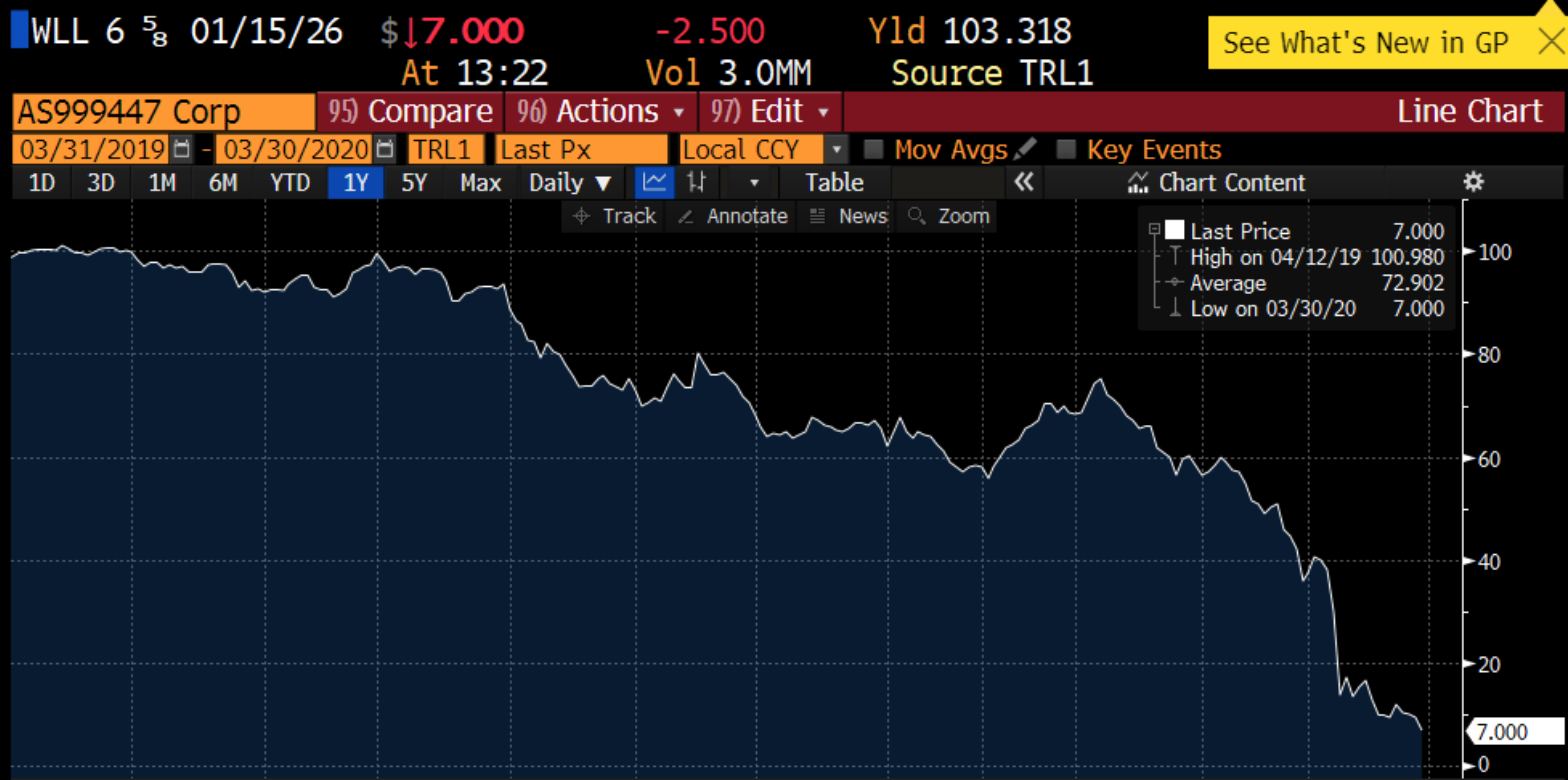⛽️New Chapter 11 Bankruptcy Filing - Whiting Petroleum Corporation ($WLL)⛽️
Whiting Petroleum Corporation
April 1, 2020
Denver-based Whiting Petroleum Corporation ($WLL) and four affiliates (the “debtors”), independent oil-focused upstream exploration and production companies focused primarily on the North Dakota and Rocky Mountain regions, filed for bankruptcy in the Southern District of Texas. This is a story that requires an understanding of the debtors’ impressively-levered capital structure to understand what’s going on:
$1.072b ‘23 RBL Facility (JPMorgan Chase Bank NA)(springing maturity to 12/20 if the ‘21 notes below are not paid in full by 12/20)
$189.1mm ‘20 1.25% convertible senior unsecured notes due 2020 (Bank of New York Mellon Trust Company, N.A.)
$773.6mm ‘21 5.75% senior unsecured notes
$408.3mm ‘23 6.25% senior unsecured notes
$1b ‘26 6.625% senior unsecured notes
You’ve heard us talk about the capital intensive nature of E&P companies so … yeah … the above $3.443b of debt shouldn’t come as much of a surprise to you. The company is also publicly-traded. The stock performance over the years has been far from stellar:
What’s interesting here is that EVERYONE knows that oil and gas has been a value-destructive sh*t show for years. There’s absolutely ZERO need to belabor the point. Yet. That doesn’t stop the debtors’ CRO from doing precisely that. Here, embedded in the First Day Declaration, is a chart juxtaposing a $100 investment in WLL versus a $100 investment in an S&P 500 index and a Dow Jones U.S. E&P Index:
We should also add that the spike reflected in the above chart in the 2017 timeframe isn’t on account of some stellar improvement of operating performance; rather, it reflects a November 2017 1-to-4 reverse stock split which inflated the reflected price of the shares. Just to be clear.
Notwithstanding the hellacious performance since 2014, the debtors take pains to paint a positive picture that was thrown into disarray by “drastic and unprecedented global events, including a ‘price war’ between OPEC and Russia and the macroeconomic effects of the COVID-19 pandemic….” In fact, the debtors come in HOT in the introduction to the First Day Declaration:
The Debtors ended 2019 standing on solid ground. While the Debtors had more than $1 billion in unsecured bond debt set to mature prior to December 2020, the Debtors had significant financial flexibility to restructure their capital structure. Most importantly, the Debtors began 2020 with a committed revolving credit facility that provided them with committed financing of up to $1.75 billion—more than enough liquidity to service the Debtors’ 2020 maturities and fund anticipated capital expenditure needs throughout the year. For these reasons, the Debtors secured a “clean” audit report as recently as February 27, 2020.
And to be fair, the debt was doing just fine until the middle of February. Indeed, the unsecured notes didn’t hit distressed levels until right after Valentine’s Day. Check out this freefall:
Who needs open amusement parks when you can just follow that price action?
Already focused on “liability management” (take a drink!) given the looming ‘21 notes maturity and the corresponding RBL springing maturity, the debtors’ retained professionals shifted over to restructuring talks with an ad hoc committee of noteholders. The debtors also drew down $650mm on their revolver to ensure adequate go-forward liquidity (and, cough, avoid the need for a relatively more expensive DIP credit facility). After what sounds like serious deliberation (and opposition from the ad hoc committee), the debtors also opted to forgo the $190mm maturity payment on the convertible notes due April 1.
The debtors filed the case with the framework of a restructuring support agreement (aka a term sheet). That framework would equitize the converts and the unsecured notes, giving them 97% of the equity (for now … debt is also still under consideration). Unsecured claims will be paid in full. Existing equity would receive 3% of post-reorg equity and warrants. Post-reorg management will get 8% of the post-reorg equity. In total, this would amount to the evisceration of over $2b worth of debt. 😬
Speaking of management, a lot of people were up in arms over this bit in the debtors’ Form 8-K filed to announce the bankruptcy filing and term sheet:
That’s right. A nice immediately-payable bonus to management.
We’d love to hear how this ISN’T a subversion of code provisions regarding KEIPS/KERPS. Seriously, write us: petition@petition11.com. Ensure stability huh? Tell us: WHERE THE F*CK ARE THESE GUYS GOING TO GO IN THIS ENVIRONMENT? But at least they’re passing up their (WILDLY WORTHLESS) equity awards and bonus payments. FFS.
Ok, fine. Maybe there were contractual provisions that needed to be taken into account. And maybe the alternative — sh*tcanning management and rejecting the employment contracts — doesn’t fit the construct of leaving an umimpaired class of unsecured creditors. Equity is wildly out-of-the-money and getting a tip here anyway. This, therefore, is just a transfer of value from the noteholders to the management. We have to assume that the noteholders, then, were aware of this before it happened. If not, they should be pissed. And the Directors — who make between $180,000 and $305,000 a year — ought to be questioned by said noteholders about potential breaches of duties.
Jurisdiction: S.D. of TX (Judge Jones)
Capital Structure:
Professionals:
Legal: Kirkland & Ellis LLP (Stephen Hessler, Brian Schartz, Gregory Pesce, Anna Rotman) & Jackson Walker LLP (Matthew Cavenaugh, Jennifer Wertz, Veronica Polnick)
CRO: Stein Advisors LLC (Jeffrey Stein)
Financial Advisor: Alvarez & Marsal LLC (Julie Hertzberg)
Investment Banker: Moelis & Company
Claims Agent: Stretto (*click on the link above for free docket access)
Other Parties in Interest:
RBL Agent: JPMorgan Chase Bank NA
Ad Hoc Committee of Noteholders
Legal: Paul Weiss Rifkind Wharton & Garrison LLP (Andrew Rosenberg, Alice Beslisle Eaton, Michael Turkel, Omid Rahnama) & Porter Hedges LLP (John Higgins, Eric English, Genevieve Graham)
Financial Advisor: PJT Partners LP
Creditor: Caliber North Dakota LLC
Legal: Weil Gotshal & Manges LLP (Alfredo Perez, Brenda Funk)






